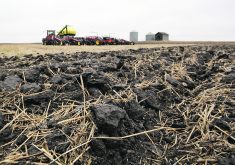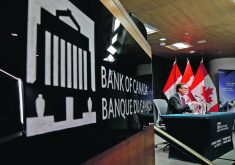Canadian producers must survive on a dwindling share of the economic pie, even as consumers face soaring food prices and are finding it harder to feed their families, said a farm leader.
Food processors and retailers are good at “leaving the impression that somehow these much higher food prices are somehow directly related to the farmgate prices,” said Stewart Wells, vice-president of operations for the National Farmers Union.
“And what we’ve seen in the last 30 years is there’s very little correlation at all. The increase in the price the consumer pays is almost all captured by the processors and the retailers, and so we wanted to make sure that these numbers were in front of the standing committee.”
Read Also

Agritechnica Day 2: The future of tractor power, building quicker crop apps and large farms and tech
Agritechnica Day 2: The future of tractor power, building quicker crop apps with Syngenta and large farms and tech
The NFU recently presented a seven-page brief to the House of Commons standing committee on agriculture, which is seeking to identify the factors behind food price inflation. The chief executive officers of several Canadian food retailers have insisted suppliers and the global market are behind the increases.
However, the situation is bringing into sharp focus a decades-long problem that predates the supply chain disruptions caused by the COVID-19 pandemic and Russia’s war with Ukraine, said Wells.
Bread prices rose steadily from 2003-16, “far outpacing the minor increases in farmgate wheat prices. In effect, retail prices were decoupled from the corresponding food inputs,” said the brief.
“Farmgate prices for wheat did increase in 2021 and 2022, potentially driven by the war in Ukraine and other factors. However, they did not come close to narrowing the gap that has steadily widened since the beginning of this data series.”
The trend extends to Canadian livestock markets, said the brief, noting the discrepancy between farmgate hog and retail bacon prices. They were “so decoupled that they moved in opposite directions: for the two years from 2014-2016, hog prices fell, and retail bacon prices rose.”
Food price inflation is not being caused by things such as supply management, said the brief.
“Price increases are occurring in both Canada and the United States for both supply-managed and non-supply-managed goods. In fact, supply management is functioning as designed to avoid drastic changes in food prices.”
The impact on producers of a system that is essentially rigged against them is to accelerate the decades-long trend of increasingly larger farms operated by fewer people to achieve better economies of scale, said Wells. It has resulted in the depopulation of rural areas, which means producers can no longer muster the same numbers at the ballot box as they did during the early 20th century when United Farmers of Alberta was able to form the provincial government, he said.
“Farmers don’t really get together now to talk about things unless it’s in the trade show format … and these companies look these farmers right in the eye and say, ‘you are the best farmers in the world. You just keep doing what you’re doing and leave all the rest — leave all the politics, leave all the regulatory pieces, leave all the other decisions — to us.”
Wells said although most of the graphs in the brief demonstrate how the gap between retail values and farmgate prices goes back to the early 1980s, things really took off somewhere around 2000-02. He targeted what he described as so-called free trade agreements that were negotiated with the help of multinational food processing companies.
The resulting deals benefited such companies, which have used their profits to absorb their rivals to the point where the few businesses left standing are not really competing against each other, he said. It gives them tremendous leverage to set the prices they pay farmers while in turn, setting the prices consumers must pay, said Wells.
“The Harvard School of Business — you don’t hear this talked about anymore — but they used to have what they called the 4-40 rule, where if you had four companies that commanded 40 percent of the marketplace, you no longer had actual competition,” he said.
“Well, it’s hard to look around now and find any kind of food product that isn’t controlled by four or fewer companies. On the other hand, when you get to the farm level, these companies, by reducing all these international trade rules to the lowest common denominator for them, they are able to force (millions of) farmers from all around the world to be in more or less perfect competition against each other.”
If Canadian farmers want more money for crops such as wheat, multinational companies can buy it somewhere else in the world for a cheaper price, he said.
“So, that’s all part of this complex matrix of rules and regulations that over the years have mitigated against the farmers.”
For more information in the NFU brief, click here.
















